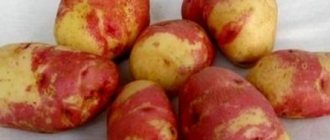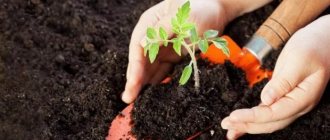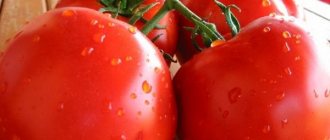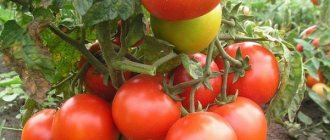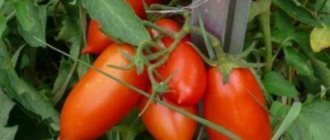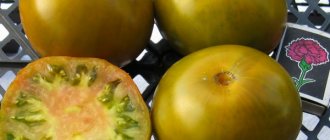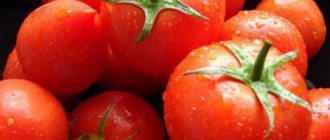Description
Hybrid f1 Ivan da Marya has replenished the tomato collection of breeder L. A. Myazina . This is a new species, which received its name due to the two-color coloring of the unripe fruits. On one side, an unripe tomato is green, and on the other side, a purple spot clearly appears. Moreover, in cool weather, the purple color predominates over the green. By the time it ripens, the purple color is almost invisible.
Distinctive features
The type is indeterminate , the height of large and spreading bushes is up to 2 m. The foliage is weak, the inflorescences are simple.
An early ripening hybrid , 90-110 days pass from the moment of sowing the seeds to full ripening.
The productivity is high , 4-5 kg of fruits are harvested from 1 seedling, provided that 3 plants are planted per 1 square meter. m.
The culture is distinguished by strong immunity to diseases of the nightshade family and is immune to late blight.
Tall growth requires obligatory gartering of the stem and fruit-bearing branches. Pruning is carried out regularly, otherwise due to the large number of unnecessary shoots, the yield is reduced.
Fruit characteristics
The average fruit weight is 200-210 g, round shape, red-brown color .
The taste is excellent, sweet, the flesh is juicy. The peel is dense and not prone to cracking, so the fruit can be stored for a long time. Transportability is excellent. The use of ripe vegetables is universal : they are used for preparing various fresh dishes and for winter preparations: canned food, pickles, marinades. They are also used for processing into tomato products, producing excellent juices, pastes and ketchups.
The photo shows Ivan da Marya tomatoes.
Disease susceptibility
Tomatoes “Ivan da Marya” f1 are not susceptible to late blight. Since the fruiting process ends before its mass distribution. It is difficult to fight other common diseases. It is best to carry out timely preventive work.
Remove damaged leaves from the plant, reduce watering, thin out the plants or loosen the soil. All this will help avoid mass destruction of plantings.
Timely treatment of plants with insecticides helps combat pests (aphids, Colorado potato beetles, and others).
How to grow seedlings
Sowing seeds for seedlings begins 2 months before planting in the ground . When planting this variety, you need to be prepared to carefully care for the sprouts.
Seed preparation
Proper seed preparation ensures healthy seedling growth , so the initial stage should be taken seriously. After a thorough inspection for visible damage, the seeds are checked for emptiness by placing them in a glass of saline solution. Those that float to the surface are disposed of, as they are not suitable for landing.
Next, the seed material is disinfected . This can be done in 2 ways: soak for 10 minutes in 2% hydrogen peroxide or place for 20 minutes in a weak solution of manganese. After disinfection, the grains are washed with running water.
To improve germination, seeds are soaked in a growth stimulator for 10 hours.
Reference! Growth stimulants increase the quantitative indicator of fruiting by 10-15%.
Container and soil
The soil is prepared from turf soil, humus and peat in equal quantities . All components are mixed and the resulting mixture is poured with a hot solution of potassium permanganate to destroy pathogenic flora. The cooled soil is laid out in planting containers, at the bottom of which small drainage holes are made in advance so that excess moisture does not stagnate.
You can plant in a common wooden box or in individual containers . Peat pots, plastic cups and paper honeycombs are used as separate containers.
Tomato growing process
You can grow Ivan da Marya tomatoes by sowing seeds in open ground or through seedlings. Gardeners prefer the second method. In this case, you can get an earlier harvest and also save most of the planting material. If seeds are sown, there is a risk of them being damaged by return frosts or destroyed by rodents.
Growing seedlings is a simple process, but it requires compliance with certain rules and is carried out in stages:
soil selection
To get strong and healthy seedlings, you should take care of proper seed preparation. Selection of quality raw materials includes the removal of damaged, broken and empty seeds. If the first and second can be determined visually, then to select the latter, the seeds should be placed in a container with warm water. Specimens unsuitable for planting will float to the surface.
Disinfection of planting material can be carried out in several ways:
- soak for half an hour in manganese solution
- place in hydrogen peroxide solution for 15 minutes
- soak for 12 hours in a solution of growth stimulants
After any procedure, the seed material should be rinsed well in running water and dried. Soaking seeds to speed up germination. To do this, they are placed in clean water for a day. After the allotted time, the seed can be planted in prepared soil or germinated. To germinate, the seeds are placed in a damp cloth and left in a warm place for several days until roots appear.
If the gardener is confident in the quality and freshness of the seed material, then it is permissible to sow them without soaking and germination.
Special soil mixtures or soil prepared independently are suitable for growing seedlings. The soil mixture is prepared from equal parts of turf soil, humus and peat. The last component can be replaced with coarse sand.
Read also: DIY cat houses drawings
Sowing seeds for seedlings can be carried out in any available container, up to 20 cm high. These can be seedling boxes, trays, cassettes, individual pots or peat tablets. Boxes, trays and cassettes are more convenient and economical, but when the young bushes grow a little, they need to be planted in separate containers to prevent the stems from stretching and the roots becoming tangled. Individual pots and tablets simplify the process and minimize the trauma to plants at the time of transplantation into open ground. Any containers must be equipped with a drainage hole.
The quality of seedlings depends on the correct sowing of seeds. Therefore, it should be carried out according to a certain scheme:
- The containers are filled with soil mixture and watered so that it shrinks. Shallow furrows (up to 1.5 cm) are formed in the soil at intervals of 5 cm (if sowing is done in seedling boxes or trays).
- The prepared seed material is placed in the grooves at a distance of two centimeters from each other and sprinkled with soil.
- The containers are covered with transparent polyethylene and placed in a warm place until the first shoots appear.
- After green shoots appear, the seedlings are placed in a well-lit place. There should be at least 15 hours of daylight, so if necessary, you should take care of artificial lighting.
- Watering the seedlings should be done carefully, especially before the first leaf appears. At this stage, you should use a spray bottle and slightly moisten the soil. When the leaves appear, watering can be done at the root. Irrigation water should be heated to 18 degrees. It should be soft. Melted is ideal.
In addition to proper sowing, seedlings need to be well looked after, because the quality of the future harvest depends on this. Caring for tomato seedlings is not difficult, but you should pay special attention to the temperature regime. Daytime temperature should be 15 degrees. It is gradually raised to 25 degrees and held until the plants begin to harden. Night temperatures should be five degrees lower.
When the seedlings reach a height of 30 cm and 3-4 pairs of developed leaves are formed on it, this is a signal to transplant the tomatoes into the ground. Healthy and developed seedlings have a thick, strong stem, short internodes and 1-2 flowering clusters.
How to grow tomatoes
After 2 months, the seedlings are ready for transplanting . By this time, the bushes reach 30 cm. They have a strong stem on which 1-2 flower clusters are formed.
Landing
The prepared area is treated with copper sulfate, thereby disinfecting the soil .
It is also possible to use biostimulants. Planting pattern : 40 cm – distance between seedlings, 60 cm – row spacing. For 1 sq. m place no more than 3 plants. When planted in a checkerboard pattern, the seedlings do not suffer from a lack of sunlight and each bush is provided with ventilation.
The holes are prepared in advance with a depth of 20 cm , a little humus and superphosphate are placed on the bottom and filled with water. After transplantation, water again and leave the seedlings to adapt to new conditions without watering them for 1 week.
Reference. When lilacs bloom, the air temperature is optimal for planting tomatoes in open ground. Many gardeners focus on this indicator.
Further care
Water strictly at the root, without getting on the leaves and without moistening the soil around the plant.
In this case, drip irrigation is ideal: a plastic bottle without a bottom is installed in the root system and filled with water, which gradually flows to the roots. After watering, the soil is loosened and hilled up to strengthen the young roots .
It is imperative to remove weeds with roots, since weeds carry many fungal diseases. When the fruits are forming, watering is stopped , since excess moisture can cause them to crack.
The culture is fed twice a month with a full range of minerals, mainly phosphorus and potassium.
The unusual color of the fruit depends on the amount of anthocyanins contained in the soil . With a significant shortage of it, ripe vegetables acquire a dirty pink color. To replenish the soil with the necessary enzyme, mustard or pea bushes are laid out between the rows. And in addition, they fertilize with bird droppings in a ratio of 1:15. The addition of organic matter is alternated with chalk or wood ash. Thus, the plant receives organic matter alternately with calcium.
Reference. Anthocyanins are natural enzymes that give plants their individual color.
Features of cultivation and possible difficulties
To bring the fruiting rate closer to the maximum , the plant is formed into 1 or 2 stems. All other stepsons are removed.
Staking tall plants is especially important during the formation of the main stem . When transplanting, a wooden or metal support is immediately installed next to each bush for fixation. Not only the stem is tied up, but also the fruit-bearing branches as they grow.
To limit growth, the tops of the bushes are pinched . This procedure is necessary, otherwise the development of unnecessary shoots will take away a large amount of nutrients necessary for the formation of fruits.
Unusual varieties of tomatoes:
Technology for growing tomato "Indigo rose"
Tomato “Blue bunch f1” for lovers of exotic varieties
Diseases and pests
Fighting diseases is much more difficult than preventing their spread .
Preventative measures are necessary to prevent the development of infections. Moderate watering with control of the level of humidity in the beds, systematic loosening, mulching of the beds, weeding and thinning of plantings are agricultural practices available to every gardener. Their implementation ensures the health of plants, strengthening their immunity. In case of fungal infection, contact fungicides are used, for example, Fitosporin or HOM.
Before planting, the seedlings are treated with Bordeaux mixture , the ground is spilled with copper sulfate, and ash is added to the soil.
Protection against insect pests is treated with insecticides . Traditional methods are also used to combat parasites: planting sharp-smelling herbs next to the tomatoes, spraying the plants with a decoction of onion peels or an infusion of weeds.
The most dangerous pests are those that live underground - they are difficult to notice. One of these insects is the mole cricket. Moving underground, it disrupts the root system and the plant dies. To keep it away from the planting beds, fish heads or crushed cloves of garlic are buried in them. These smells scare away the mole cricket.
Spider mites are dangerous for tomatoes in greenhouses . Its habitat is warm and high humidity, so it is important to ventilate protected structures every day. The influx of fresh air destroys the parasite’s usual habitat.
Distinctive features of the variety
The variety Ivan da Marya is a new hybrid from Myazina’s collection. It got its name from its contrasting color. Unripe fruits are bicolored: the lower part is green, and the reverse side is decorated with a pronounced purple spot. The cooler the nights, the larger the spot becomes. When ripe, the stain is almost invisible, leaving only a brown coating on the skin.
The fleshy pulp of the fruit has a pearl-brown color, a pronounced herbal aroma and a sweet taste.
The average weight of tomatoes reaches 210 grams. Tomatoes are collected in heavy clusters. The shoots are also purple in color. The bushes are tall and can reach two meters in height. The shoots are lightly leafy and do not need pruning. But it is necessary to plant the bushes - this increases the quantity and quality of the harvest. Pruning is carried out in one or two stems, the top is cut off, leaving a couple of leaves above the brush.
Ivan da Marya is a very early hybrid. Fruit ripening occurs 90-110 days after planting the seedlings. Ripe tomatoes are brown-red in color. They are suitable for all types of processing and preservation, as well as for fresh consumption. Tomato productivity is high. From one bush you can harvest up to five kilograms of vegetables, and three bushes are planted per square meter.
The nuances of growing in open ground and in a greenhouse
Growing Ivan da Marya tomatoes is possible in two ways : through seedlings and sowing seeds directly into open ground. Of course, the second method can only be used in southern regions with long and warm summers. However, gardeners prefer growing through seedlings, claiming that this is how they get a larger harvest. There is also a risk of return frosts in open ground.
When growing a crop in greenhouse conditions, seedlings are planted less often than in open beds. Tall bushes need a sufficient amount of light for full development, and with frequent planting they will shade each other. In addition, thickening increases the likelihood of fungal infections.
In open ground, gardeners advise placing the beds from the east to the west to receive long-term sunlight.
Planting and care
When growing, the seedling method is most often used. Since sowing seeds in the ground may result in the loss of seedlings as a result of spring frosts, or the seeds themselves will suffer due to rodents.
After the second leaf appears, the tomatoes dive. This will prevent the plant from stretching and the roots becoming tangled. Thereby reducing stress when transplanting to a permanent place.
It is necessary to carry out pinching and removal of the growing point.
A plant of the “Ivan da Marya” variety is formed into two stems. This will increase the harvest volume and fruit size. 3 plants are planted per 1m2.
Tomatoes do not require care. Watering, loosening, weeding and fertilizing are the main agricultural techniques used during the growth of tomatoes.
Harvesting and application
Ripe vegetables begin to be collected from the end of June . The fruits are used universally: they are consumed fresh for preparing hot and vegetable dishes, they make excellent salads and a variety of snacks. The unusual color allows you to use vegetables as decoration, decorating any dishes.
Smaller tomatoes are used for whole-fruit canning , as they look very elegant in glass jars. They are also salted and pickled. Delicious juices, pastes and ketchups are obtained from processed tomato products.
Ripe tomatoes, thanks to their durable peel, are subject to long-term storage and can withstand long-term transportation, maintaining their presentation for a long time.
Proper care of tomatoes
When the seedlings take root and begin to grow, they will require standard care, which consists of regular watering, fertilizing and forming bushes:
- Watering. Water the tomatoes at the root, preventing the soil around the plants from getting wet. To make the process easier, you can bury plastic bottles with cut bottoms near the shoots and use them as funnels. This trick allows you to nourish the roots of plants without spilling water. Daily watering is carried out if the weather is dry. The procedure should be carried out in the evening, when the sun is not so active. When the fruits are forming, watering is stopped so as not to provoke cracking.
- Feeding. Tomatoes are fed twice a month using solutions of mineral phosphorus-potassium mixtures. The unique color of Ivan da Marya tomatoes depends on the amount of anthocyanins in the soil. With its deficiency, tomatoes acquire a dirty pink color. To maintain the required acid-base balance in the soil, you can place cut mustard or pea bushes in the rows. And also fertilize with chicken droppings. In the absence of rain, it is diluted with water and applied at the root. It is recommended to alternate this feeding with chalk or ash. In the first week you need to add litter, and in the next week you need to add calcium.
- Formation of bushes. When the tomato bushes begin to actively develop and grow, you should remove excess side shoots, leaving one or two main stems, the tops of which should be pinched. When carrying out the procedure, there is no need to leave stumps on the stems - they increase the risk of re-development of lateral stems. Correct and timely formation will reduce the risk of diseases and increase the amount of harvest.
Advantages and disadvantages
this section with positive characteristics :
- possibility of propagation by seedlings and without seedlings;
- stable immunity to diseases;
- high fruiting rate;
- good adaptation to weather conditions;
- excellent taste of fruits;
- marketable condition;
- unusual color;
- long-term storage and transportation;
- versatility in cooking.
Negative qualities include:
- more complex care compared to other tomatoes;
- belonging to hybrids and the impossibility of independent seed selection.
What is the variety
Considering the characteristics of the variety, you can get an excellent harvest. Correctly positioning the plant on the site, using all the necessary agrotechnical techniques.
- Inflorescence: simple.
- Height: up to 2 m.
- Ripening time: 90–110 days.
- Shape: round.
- Color: brown-red.
- Weight: up to 210 gr.
- Density: high.
- Taste: sweet.
- Skin: tough.
- Transportability: good.
- Shelf life: long time.
Farmer reviews
The main indicator of the success of any culture is the presence of many positive reviews . The Ivan da Marya tomato has enough of them.
Konstantin, Kaluga : “The hybrid attracted me with its characteristics. What surprised me the most were the fruits. The variety has become a kind of decoration for the site. I will definitely grow it next year. Tomatoes are great for canning and preparing other preparations for the winter.”
Natalya, Saratov : “I can’t say that the hybrid required increased attention during the growing season. She fed, fed, watered, tied up. But the result is fantastic! I've never seen such beautiful tomatoes! I’ll definitely plant them next year.”
Opinions of summer residents regarding tomatoes “Ivan da Marya”
You can preliminary evaluate a plant by the presence of positive responses. The reviews contain a lot of useful information. After studying them, you can make the final decision when choosing a variety.
- Natalia. We tried growing tomatoes in open ground and in a greenhouse. Comparative analysis did not show significant differences. The tomatoes differed from each other only in taste. The fruits tasted better when grown in the open ground. The first ones began to bear fruit.
- Konstantin. While retired, my wife and I started breeding a variety of unusual varieties of tomatoes. “Ivan da Marya” attracted us with its characteristics. Most of all, friends were amazed by these fruits. The variety was a kind of decoration for the site. They will definitely grow it next year. Tomatoes are great for canning and preparing other preparations for the winter.
An unusual plant will decorate any area. Black-fruited tomatoes “Ivan da Marya” will not leave indifferent any guest who has visited the site. And with their unpretentiousness they will win the heart of even an experienced summer resident.
Tomatoes of unusual colors are especially popular. The fruits can be yellow, green, purple and even black, like the Ivan da Marya tomato, reviews of which are mostly positive. These tomatoes are in great demand, as many are confident that black tomatoes are healthier than red ones.
Fruit tomatoes: new hybrids of the author's selection
I want to introduce you to my new work, tell you about the hybrids, which I conventionally called tomatoes-fruits
(for their special taste). Their fruits reach 200–400 g. The plants are tall and sparsely leafy. Among them you can choose carpal, fleshy, juicy and large-fruited hybrids.
Tomato cluster hybrids
Hybrid Liqueur
can be classified as cocktail tomatoes.
- He is the earliest. 77 days have passed since the sprouting loops appeared, and now we are already seeing the first brown fruits on complex long clusters.
- Fully ripe fruits weighing 25–30 g will be a rich orange color.
- Tomatoes are sweet, with thick skin; fruits have 2 chambers; The pulp and center are dense, and the liquid with the seeds is juicy.
It turned out to be a rich combination! The plant will delight you until late autumn.
The fruits can be “accumulated” and collected with brushes - they do not crack. In this case, watering is necessary only after harvesting the fruits.
tomato variety Liqueur
Coliseum
and
Gladiator
- slightly ribbed large fruits, when ripe they will be orange and red in color, respectively.
- The internal structure of the fruit will make it easy to separate the pulp from the thick wall and, if desired, use them not only for salads, but also for stuffing.
- Grows up to 10 even fruits in a complex cluster.
- Bright tomatoes laid out on a dish will add a festive mood even on a weekday.
Colosseum variety
Juicy tomato hybrids
For lovers of juicy tomatoes, I offer the following varieties:
- Balance
– large, juicy fruits of bright orange color on complex clusters; - Beauty Queen
- red fruits of excellent taste, reaching a weight of 250 g, on complex clusters; - Beauty
- when ripe, it has red fruits (about 300 g) with melting pulp; - Safari
- fruits of the most delicate taste, the same size as Prelesti, but orange in color.
| For lovers of tomato juice with pulp, I note that when processing the ripe fruits of these hybrids, the juice yield will be the highest. |
Tomato hybrids Balance and Safari
Tomato with a “nostalgic” name Retro
will take you back to a time when trees were big and mom’s salads and juices were delicious. A simple cluster produces red fruits with an average weight of 350 g.
Hybrid Retro
"Fleshy" tomato hybrids
For those gourmets who like to prick dense “cubes” onto a fork, I would recommend the “fleshy” fruits of the following hybrids with red fruits:
- Balm
– flat-round, about 300 g; - Benefit
– excellent taste, round, dense, about 300 g; - Disco
- smooth fruits, weighing about 350 g, bright red, very tasty
; - Miss World
- 10 fruits weighing about 200 g grow in a brush; - Lake of Hope
- delicious fruits weighing 250 g. 8–10 fruits grow on a simple cluster. - The Doctor Summer
hybrid has dense orange pulp, with an amazing combination of sugars and acids.
tomato hybrid Disco
Hybrid Chelyabinsk meteorite
– my gift to the tireless Vladimir Vasilyevich Stepanov, head of the Chelyabinsk NGO “Gardens of Russia”, for his anniversary. Ripe fruits are fiery orange in color, large, dense, with an “unearthly” taste.
hybrids Doctor Leto and Chelyabinsk meteorite
Hybrid Ivan da Marya
I named it so for the bright contrast: it has a purple spot on the unripe fruit, and the lower part is light green!
- When ripe, the spot is barely visible by the brownish coating on the skin.
- Under the skin, the pulp is moiré with a sheath, with the smell and taste of aromatic herbs!
- The fruit weighs 200 g, the pulp is dense, the purpose is universal.
Please note that the entire stem has an anthocyanin (purple) color to the top. The lower the night temperatures, the larger the spot on the fruit will be!
hybrid tomatoes Ivan da Marya
